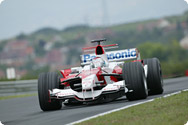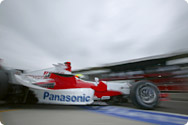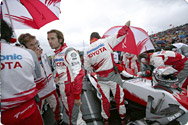My continuing thanks to our many fans, and your support of Panasonic Toyota Racing. Here is my report from the Hungarian Grand Prix.
Our Goal: A two-car finish with both cars in the points
Here in Hungary, the weather is cool enough to make you think that maybe summer is over. Usually, Hungary is very hot at this time of year, but I recall that 2004 was comparatively cool as well. Actually, we projected a chance of cooler temperatures since Hockenheim, so we were not extremely surprised at the temperatures.
 |
 |
| To get the most downforce at the demanding Hungaroring, Panasonic Toyota Racing came to Hungary with the same bolt-on winglets used in Monaco. The team did make some detailed modifications to the winglets before Hungary. |
|
We made our tire preparations projecting hotter weather in Hungary, but we didn't feel panicked that the cool weather would affect our performance irretrievably. We did, however, take extra care in preparing for the race.
The Hungaroring is on par with Monaco as a circuit demanding more downforce than any other during the season. While the exterior of our cars might look exactly like the Monaco setup, the package we brought to Hungary featured some improvements we were able to make in the interim. We changed Jarno to a fresh engine last race, so his engine was on its second grand prix. Ralf had a fresh engine on board.
Everything ready, but unseasonably cool weather causes some headaches.
A one-word recap to describe Friday would be "cold." We did look at the weather reports, and believed we used the week effectively to get ready, but the actual conditions here in Hungary were very difficult to deal with. I thought to myself that it was a bad situation. I was worried, since the temperatures were extremely low compared to the usual Hungarian summer heat.
| |
 |
 |
Hungary was cold, as indicated by some of the attendees in winter long sleeve wear. The cold prevented Panasonic Toyota Racing from getting the best use out of their tires, and also caused concerns about graining (fraying on the tire surface) |
 |
With France being so hot, we thought that Hungary might even be hotter, so we came with strategies designed to deal with the heat. We ended up having discussions as to how much we would close off the ventilation holes we had made in the chassis for cooling the car. The situation on the ground was quite different than everyone expected.
Not only did the weather play havoc with our cooling strategy, but the tires were also performing worse than expected with the cool weather. Coming in looking for hotter temperatures, our spec was designed for a track surface somewhere in excess of 50ºC, while we expected the race surface to be about 40ºC, and ambient temperature somewhere between 25ºC and 30ºC, but the weather turned out to be much cooler than that.
As a result, we ran into tremendous time loss issues. We struggled to find how much fuel we could load without significant time loss, and how light a fuel load we could reasonably run. We knew that the fuel load question would be very important during qualifying. But with every team dealing with the same difficult circumstances, we kept in mind going into Saturday that our most important task was to get both cars in top shape.
Slower than hoped, but both cars qualify in the top 10
Our qualifying performance was not quite as strong as we had hoped. With a few drivers being penalized and moved farther down the grid, we ended up with P6 and P8 on the grid, but I came away feeling that our times were slower than we wanted. I wished we could have pulled at least a little more speed out of the cars. I suppose I can't be too unreasonable, but leaving aside tire selection and race strategy, I would have felt more confident if we were close to the front of the grid.
 |
 |
|
During its history, the Hungarian Grand Prix has only seen two rainy race days-the inaugural Hungarian Grand Prix race and the race this season. Tire selection was difficult prior to the race, but the team ultimately chose to go with intermediate tires. |
|
Our main concern was tire graining (fraying tire wear). While our situation wasn't necessarily worse than any other team, it was still something to be concerned about. Our analysis was that our times were affected by not being able to hit the "sweet spot" in our tire usage. Of course, we wanted quick single-lap times during qualifying, but we also considered tire stability during the race, and we believed that we selected the best tires to perform under both qualifying and race conditions.
We also noted a time gap between Ralf and Jarno, but I think the difference was more related to their individual driving styles. It looked like Ralf's tires came up to temperature better than Jarno's. While I had some minor frustrations with lap times, at least there weren't any mechanical issues that kept the cars off the track. We felt strongly that if both cars completed the entire race, then we would stand to win a good share of the points, and I think things went well on that front.
Happiness at winning points for the fifth consecutive race; sadness as Jarno's premature retirement
First of all, I want to congratulate Honda on their victory. Their win has provided us with extra encouragement in our efforts. We have a renewed, even stronger desire to win as quickly as possible.
I think we did what we should have during the race. Our start wasn't the best, and our lap times on the first and second sets of intermediate tires (tires for slightly wet surfaces) were too slow. I think our final result was simply a reflection of these two factors.
| |
 |
 |
While the timing for changing over to dry tires could be judged as nothing less than perfect, the timing of the safety car couldn't have been worse, coming out just after Ralf and Jarno made their first pit stops. The result was a lap lost to the race leaders.
|
 |
My impression about our start was that the grip was extremely poor at the split second after acceleration. Because of that, we lost quite a few positions during the first lap. The rain stopped for a short time, and then started to fall again, keeping our tires from warming up properly, and resulting in lagging lap times.
Another bad bit of luck was the timing of the safety car. Ralf had been battling Michael, but during the time that the safety car came out, a one-lap gap emerged between the two. Ralf had shown indications of catching Michael, who had been as high as second, so the turn of events was very disappointing.
Ralf and Jarno pitted on laps 47 and 48, respectively. We changed them to dry tires, and I think it was perfect timing. In my opinion, the dry tires were one factor leading directly to Ralf's strong results. On the other hand, if we hadn't changed them at that time, our drivers would probably have had to come in again later.
Ralf finished 6th, making this our fifth consecutive race in the points. But more than that, we were all shocked by the catastrophic engine failure on Jarno's car so close to the finish of the race. We have three weeks before the Turkish Grand Prix, and while we won't be able to test, we certainly won't be sitting on our hands. We have plenty of time to reexamine the results of this weekend, and our goal is to regain our balance, and head into the next race. I look forward to your continued support at the next race in Istanbul. Thank you.
|